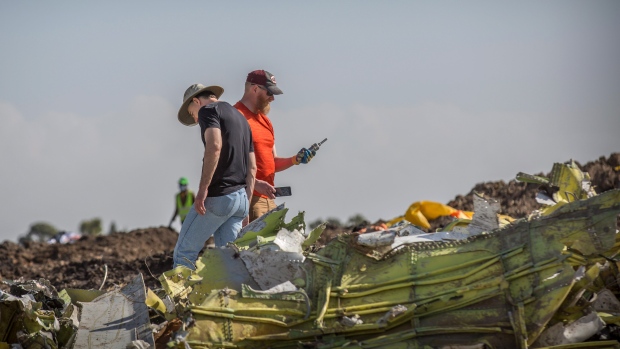Mar 15, 2019
Piece of crash wreckage is said to show Boeing 737 Max was set to dive
, Bloomberg News

A screw-like device found in the wreckage of the Boeing Co. 737 Max that crashed last Sunday in Ethiopia indicates the plane was configured to dive, a piece of evidence that helped convince U.S. regulators to ground the model, a person familiar with the investigation said late Thursday night.
Federal Aviation Administration chief Daniel Elwell on Wednesday cited unspecified evidence found at the crash scene as part of the justification for the agency to reverse course and temporarily halt flights of Boeing’s largest selling aircraft. Up until then, American regulators had held off as nation after nation had grounded the plane, Boeing’s best-selling jet model.
The piece of evidence was a so-called jackscrew, used to set the trim that raises and lowers the plane’s nose, according to the person, who requested anonymity to discuss the inquiry.
A preliminary review of the device and how it was configured at the time of the crash indicated that it was set to push down the nose, according to the person, who wasn’t authorized to speak publicly about the investigation.
The jackscrew, combined with a newly obtained satellite flight track of the plane, convinced the FAA that there were similarities to the Oct. 29 crash of the same Max model off the coast of Indonesia. In the earlier accident, a safety feature on the Boeing aircraft was repeatedly trying to put the plane into a dive as a result of a malfunction.
All 157 people aboard Ethiopian Airlines Flight 302 died early Sunday shortly after the plane took off. The pilot reported an unspecified problem and was trying to return to the airport. The plane crashed near Addis Ababa, Ethiopia’s capital. The plane’s crash-proof recorders have been sent to France to be analyzed.
The discovery of the jackscrew was earlier reported by NBC News.
Separately, the New York Times reported that doomed Ethiopian Airlines plane was in trouble almost immediately after takeoff as it lurched up and down by hundreds of feet at a time. The captain of the Boeing Co. 737 Max 8 asked in a panicky voice to turn back only three minutes into the flight as the plane accelerated to abnormal speeds, the newspaper reported, citing a person who reviewed the jet’s air traffic communications.





